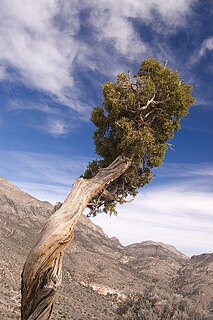
Junipers are coniferous trees and shrubs in the genus Juniperus of the cypress family Cupressaceae. Depending on taxonomic viewpoint, between 50 and 67 species of junipers are widely distributed throughout the Northern Hemisphere, from the Arctic, south to tropical Africa, from Ziarat, Pakistan, east to eastern Tibet in the Old World, and in the mountains of Central America. The highest-known juniper forest occurs at an altitude of 16,000 ft (4,900 m) in southeastern Tibet and the northern Himalayas, creating one of the highest tree-lines on earth.

Juniperus communis, the common juniper, is a species of small tree or shrub in the cypress family Cupressaceae. This evergreen conifer has the largest geographical range of any woody plant, with a circumpolar distribution throughout the cool temperate Northern Hemisphere from the Arctic south in mountains to around 30°N latitude in North America, Europe and Asia. Relict populations can be found in the Atlas Mountains of Africa.

Juniperus oxycedrus, vernacularly called Cade, cade juniper, prickly juniper, prickly cedar, or sharp cedar, is a species of juniper, native across the Mediterranean region from Morocco and Portugal, north to southern France, east to westernmost Iran, and south to Lebanon and Israel, growing on a variety of rocky sites from sea level up to 1600 m elevation. The specific epithet oxycedrus means "sharp cedar" and this species may have been the original cedar or cedrus of the ancient Greeks.

Juniperus excelsa, commonly called the Greek juniper, is a juniper found throughout the eastern Mediterranean, from northeastern Greece and southern Bulgaria across Turkey to Syria and Lebanon, Jordan and the Caucasus mountains.
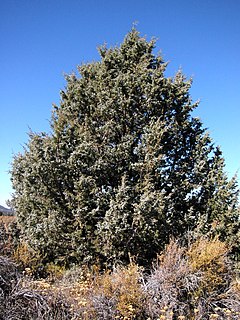
Juniperus occidentalis, known as the western juniper, is a shrub or tree native to the western United States, growing in mountains at altitudes of 800–3,000 metres (2,600–9,800 ft) and rarely down to 100 metres (330 ft). It is listed as Least Concern on the IUCN Red List because it is a widespread species with an increasing population.

Juniperus sabina, the savin juniper or savin, is a species of juniper native to the mountains of central and southern Europe and western and central Asia, from Spain to eastern Siberia, typically growing at altitudes of 1,000-3,300 m ASL.
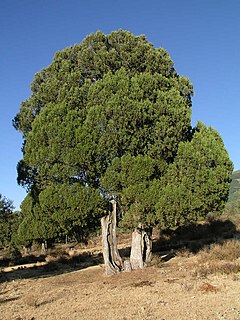
Juniperus thurifera is a species of juniper native to the mountains of the western Mediterranean region, from southern France across eastern and central Spain to Morocco and locally in northern Algeria.
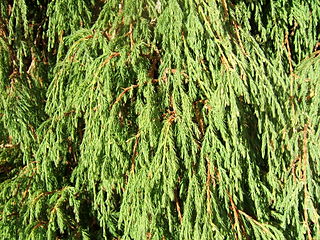
Juniperus recurva, commonly named the Himalayan juniper or drooping juniper, is a juniper native to the Himalaya, from northern Pakistan east to western Yunnan in southwestern China. It grows at 3,000-4,000 m altitude.
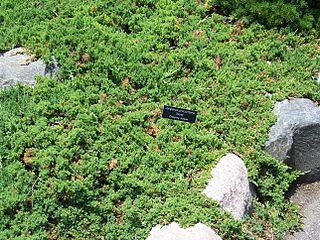
Juniperus procumbens is a species of shrub in the cypress family Cupressaceae, native to Japan. This low-growing evergreen conifer is closely related to the Chinese juniper, Juniperus chinensis, and is sometimes treated as a variety of it, as J. chinensis var. procumbens.

Juniperus squamata, the flaky juniper or Himalayan juniper, is a species of coniferous shrub in the cypress family Cupressaceae, native to the Himalayas and China
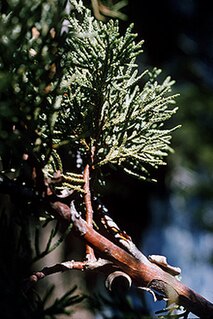
Juniperus deppeana is a small to medium-sized tree reaching 10–15 m tall. It is native to central and northern Mexico and the southwestern United States. It grows at moderate altitudes of 750–2,700 meters (2,460–8,860 ft) on dry soils.

Juniperus flaccida is a large shrub or small tree reaching 5–10 m tall. It is native to central and northern Mexico and the extreme southwest of Texas, United States. It grows at moderate altitudes of 800-2,600 m, on dry soils.
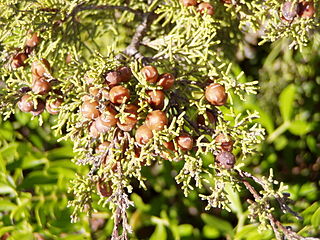
Juniperus phoenicea, the Phoenicean juniper or Arâr, is a juniper found throughout the Mediterranean region, from Morocco and Portugal east to Italy, Turkey and Egypt, south on the mountains of Lebanon, the Palestine region and in western Saudi Arabia near the Red Sea, and also on Madeira and the Canary Islands. It mostly grows at low altitudes close to the coast, but reaches 2,400 metres (7,900 ft) altitude in the south of its range in the Atlas Mountains. It is the vegetable symbol of the island of El Hierro.
The wildlife of Iran include the fauna and flora of Iran.
Juniperus lutchuensis is a species of juniper, native to the Ryukyu Islands, Izu Ōshima and the adjacent coast of Shizuoka Prefecture in Japan.
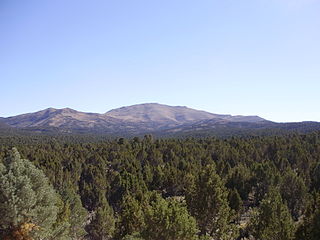
Pinyon–juniper woodland, also spelled piñon–juniper woodland, is a vegetation type (biome) of Western United States higher elevation deserts, characterized by being an open forest dominated by low, bushy, evergreen junipers, pinyon pines, and their associates which vary from region to region. The woodland's crown height may vary from less than 10 meters up to 15 meters, depending on the site. It may consist of pure stands of pinyon pine, or pure stands of juniper.

The Western Himalayan subalpine conifer forests is a temperate coniferous forests ecoregion of the middle and upper elevations of the western Middle Himalayas of Nepal, India, and Pakistan.

Zarghun Ghar, or Zarghoon Mountains, is a mountain range located in the east of the Quetta District, in Balochistan Province, western Pakistan. It contains the tallest mountain in the Balochistan region. The range is home to a broad swathe of flora and fauna.
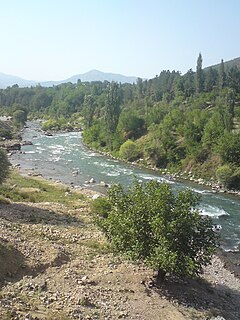
The Gissaro-Alai open woodlands ecoregion covers the western foothills winding around two western offshoots of the Tian Shan Mountains in western Tajikistan, and parts of eastern Uzbekistan and western Kyrgyzstan, in Central Asia. The woodlands are typically of Juniper trees and shrubs, fitting the altitude zone situated between the desert valley floor, and the tree line, above which the mountain ridges are glaciated and barren.

Juniperus seravschanica is a species of juniper. Common names include Pashtun juniper.



















